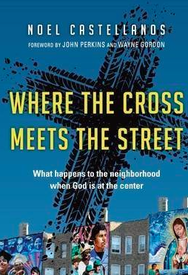Intentional outputs promoting social mapping affirming mutuality and equality among persons10/31/2015 Introduction to the last section: A Temple-Church Architecture Reorienting Trajectory: Personhood OutcomesWith a contextually wider view of the Ephesians Letter, one of the outcomes of God’s cosmic reconciliation through Messiah can be seen in the transformation of the principal Roman social unit into relationships of reciprocity [see Russ Dudrey, “‘Submit Yourself to One Another’," RestQ, v 41/1]. This is even more substantial when we consider that the household code setting is framed within a temple-church venue, God’s new sacred place where believers gathered as the locally enfleshed fullness of Messiah’s body (cf. 1:22-23). Our observations of the code and its literary connection to the Spirit-filled temple-church (see Eph 2:19-22; 5:18) provoke us to reimagine potential relevant outcomes for the significance of how Paul works the household code text (5:22-6:9). The priority of the “lesser” household member (i.e., wives, children, slaves) in each pairing and the leveling of the male head of household through the expected reciprocity to the “lesser” members suggest that personhood (or the recognition of personhood) is an appropriate contextual outcome for the command to be filled in Spirit (5:18c). God’s new humanity (2:15c) is a result (an outcome) of his cosmic reconciliation (his output). Thus, the growing household temple-church in Spirit (2:19-22; 5:18-6:9) is God’s recreated sacred space where (a local) church growth is measured by local “church” habits and intentional outputs that promote a socially constructed reality wherein social mapping affirms mutuality and equality among persons (outcomes). *For those following my thoughts on "Church Growth" here are some concluding thoughts as I prepare for the upcoming November 2015 annual meeting of the Evangelical Theological Society in Atlanta.
Other Not by the Numbers posts >>
0 Comments
In some circles "incarnational" has become a standard, almost cliché, term for how ministry and mission are to be expressed. If it is not incarnational, then it isn't authentic biblical ministry goes the idea. I confess, for most of my Christian life, I have resisted using the term as a shibboleth for Christian ministry. Mostly because I am opposed to rating the authenticity of ministry through a trend and a cliché. Nor, am I convinced that it is a biblical term for ministry--in other words, it hasn't been exegetically vetted very well. It is a cliché. The word "incarnational" means an imitation of the incarnation of the second person of the trinity, the Son of God, who became flesh (a man) and physically dwelling, as Jesus did, in the midst of people. Some just simply mean, "Being Jesus in the midst of people." An incarnational Christian enfleshes the good news of Jesus in ministry to others. In other words, the very same work that Jesus did--incarnational work—is now our task. I get this. Sounds, even, well, biblical—as if there are Bible verses that can be pointed to for backing up the concept. Yet, Jesus' incarnation will never be something I can actually do—I am not God become man, nor am I man who can become the Son of God. So I am cautious on using the term incarnational for how I view ministry. (I am less cautious when the incarnational image is applied to a local church's ministry, which at least should reflect Paul's teaching on the church being Messiah's body, as in Ephesians 1:22-23, and, thus, an ascension ministry, not an incarnation one. But this is for another post.) I get the idea and the concept, but the way I have heard incarnational used has been mostly to indicate that if you are not doing ministry "this way," you are doing it wrong or not doing it Jesus' way. I know that doesn't make me popular within the more progressive Christian community (who seem very attracted to the word), but, as Inigo Montoya from the movie Princess Bride said, “You use that word a lot. I do not think it means what you think it does.” With this said, there is yet another idea behind the concept of incarnation that isn't as cool or attractive to apply. I find Mary's song very instructive on the matter, for her song is about the incarnation of Jesus and it is a lament. In order for true incarnational ministry and mission to happen, Mary’s song needs to come true. Her song is a good test for God-centered, Jesus-like incarnational ministry. (Reread the song above.) Mercy on those who fear God (for destruction like 70AD is coming upon us, too, when we least expect it.) Poor communities will become the wealthy and the privileged rich shall become the poor. For God will remember in these days of idolatrous modernity and affluence; days in which the marginalized are treated unjustly while abundance throughout the church is hoarded; times where Christians are more about status and celebrity, and the people of God trust in the structures of Empire for protection and prosperity—for God in the midst of these will remember His mercy as He spoke to our fathers, to Abraham, the heir of the world, and as he spoke to that small band of believers facing peril and destruction at the birth of the church. Just as the babies of Bethlehem and Jerusalem faced the sword at Jesus’ birth, his incarnation (shortly after Mary's song), praying for incarnational ministry may very well mean the destruction of the innocent around us. True incarnational ministry is not for the faint-hearted. We should be mindful for what we are advocating and calling Christians to do when we plead for incarnational ministry. Mary's song is a lament. Rereading it brought to mind something that Soong-Chan Rah wrote in his Prophetic Lament, but with a slight twist in the direction of its application: “The collapse of the old order of modernity may be the right event at the right time. However, like the nations that have grown rich from Babylon, how much has American Christianity grown rich from the systems that elevated Western expressions of modernity?” (Prophetic Lament, 77). Soong-Chan Rah, my fellow Gordon-Conwell Theological Seminary alum, isn’t wrong to raise this question. As modernity and with it Christendom (a form and system of civil religion built and sustained on American modernity) has begun to fail, we should not think we get to keep all our toys and get to maintain the ways our American evangelical churches prosper as these leveraged systems of thought and sustainability collapse around us.
I also fear that much of the rising privileged from among Christian social justice advocates, who call for incarnation ministry and who have taken on the mantle of speaking truth to power, are also sustained by the very system they denounce. It is hard to be prophetic with a secure bank account, the spot light of celebrity shining on them, now living in privileged neighborhoods, and, as well, hanging their prophetic angst on the hangers of modernity (e.g., mass production, advertising, and the glitter of spectacular conferences that magnifies their status as celebrity prophets). Do not think for one moment that the social advocacy industry (Christian or not) and our mega-social-justice stars (Christian or not) get to keep their own toys as modernity and, with it, Christendom collapses. As Jeremiah, in his Lamentations reminds us, all will become victims of the destruction of idolatrous systems of society, civil and religious. Exile is (or will be) the condition for all as a result. Simply exchanging the place of the privileged with ourselves isn’t a prophetic voice. Like the captain of a ship, incarnational Christians must come to grips with the privilege of such a high calling and the code of such responsibility: Incarnational ministry means going down with the ship (i.e., down with those whom we are ministering to incarnationally as Jeremiah and as Jesus did--the cross is the end of an incarnation ministry, caught between two thieves). We should, rather, expect, as the Old Testament prophets did, to share in the judgment of exile, in torture, mockings and scourgings, yes, also chains and imprisonment. Maybe even being subject to death by the sword as well. (Not book deals, the affluence of celebrity status, and the adulation of conference speaking.) As those seeking to be that prophetic voice to the destructive and privileged powers of our times, until we are willing to go about in sheepskins, in goatskins, being destitute, afflicted, ill-treated, wandering in deserts and mountains and caves and holes in the ground (see Hebrews 11:35-38), we will not be the incarnational prophetic voice we claim, but simply those who want the power for ourselves and our kind (because they've had it long enough). In the end, we cannot have incarnational ministry without the humbling of lament. Lament exposes, peels, scrapes and strips the powers of the age off our flesh, so we may have authentic incarnational ministry. Heading into my last section of my ETS paper on Ephesians 5:18 and the following household code. The focus of the paper is to build an exegetical foundation for church growth (the definition, outputs, and outcomes). For those interested and keeping up on my study, here is the introduction to the last section (or at what appears as the last section for now.Reorienting Trajectories of Temple-Church Architecture: Personhood Outcomes The Ephesians 5 household code passage is perhaps one of the more contentious texts concerning Christian approaches to marriage and, generally, for the inferences made from it regarding the “biblical” role of women in the church and in society. There are three general categories for how the Ephesians wives-husband passage (5:22-33 and other NT women/wives related texts) is classified in regards to Christian-related concepts of the “role of women.” There is the patriarchy view that leaves the man as the sole authority within the family and central to all social ordering in and outside the church. In regards to marriage, women exist to be wives for the purpose of serving the male. The complementarian view, on the other hand, understands that men and women are equals as image bearers of God and both, as Christians, are equal with respect to salvation and their position before God, equally valued in the sight of God. However, their roles and responsibilities within the church are not equal; women ought not to serve in positions of church lay-leadership (i.e., elders, under-shepherds, etc.) or in ordination as pastors. In marriage and within the household, women are to submit to their husband’s spiritual and decision-making leadership. Finally, the egalitarian (or mutuality) view promotes gender equality, viewing home-life as co-partners sharing equally in all aspects of married life and advocates for the inclusion of women in all leadership roles and offices within the Christian community and in the church. In light of our contextual observations in the last section, however, we should consider another paradigm to determine Paul’s intentions for his use of the household code (5:22-6:9) following his command to be filled in Spirit (5:18). There is a strong and dynamic intra-textual relationship between the Ephesians 5 filling command, the following household code, and the church as temple (Eph 2:19-22; 5:18-6:9). This suggests that the relationship-trio (5:22-6:9) functions as the architecture of the temple-church, that is, at least in part, a manner in which the whole building, being fitted together, is growing into a holy temple in the Lord, in whom you also are being built together into a dwelling of God in Spirit (Eph 2:21-22). In other words, Paul harnesses the concept of the well-established Roman household code or table for at least one answer to the questions How does the temple-church grow? and, in light of the command to be filled in Spirit, How is the temple-church being built together into a dwelling of God in Spirit? The Eph 5:15-6:9 pericope, then, should be considered a potential church growth text that presents potential trajectories that promote growth outputs and outcomes beyond numbers of people. *For those following my thoughts on "Church Growth" as I prepare a paper for the upcoming November 2015 annual meeting of the Evangelical Theological Society in Atlanta. This portion comes from the paper entitled, "Domesticating Church Growth (Eph 5:18-6:9): The Spirit-Filled Temple-Church Architecture (Wives-Husbands/Children-Fathers/Slaves-Masters) and Outcomes of Personhood."
Other Not by the Numbers posts >> The ecclesiastical and liturgical changes that developed at the move from domestic-center church to building-centered church set the Christian community on social mapping trajectories that have affected, not only views on the role of women in the church, but how we also define and understand church growth outputs and outcomes. The distinct change from domestic space with more informal domestic relationship oriented habits and associations to a more formal institutionalized ecclesiastical space has, over two plus millennia, created specific social ramifications for the church and for doing church. And, as well, this has influenced what we consider acceptable church growth texts. We should not underestimate the power of a building as “a church.” As Jeanne Halgren Kilde reminds us, the “material world is far from neutral,” nor is a “church building” any less neutral [Sacred Power, Sacred Space: An Introduction to Christian Architecture and Worship, 199]. Although reflecting on earlier church history, yet still valid to our contemporary building-centered church, Kilde continues, “Christian space is dynamic space. It is powerful space” [199]. The power of sacred space, including a building designated as “a church,” changes everything. Power shifts. Sustainability becomes necessary. Maintaining approved and acceptable hierarchies become absolute. Habits associated with the use of a “sacred” building and the division it makes with everyday life orients our social mapping. A building-centered church experience is not nuetral to the church’s associations and human relationships in and outside the church community (i.e., a local church community). The use of building-centered sacred space as church is a language itself, a specific “god-talk” that that creates a separation from other non-sacred church space, reinforcing a incongruence, a cleavage between everyday life and, also, a barrier between human and human social mapping (or a redefining of social mapping). The shift to now long entrenched habits and meaning associated with building-centered, addressed sacred space made with human hands known as “a church” has provided an interpretive lens for reading the New Testament. The question is not whether we should have specific buildings as centers of “church” activities, but how such building-centered church experiences influence and mold both our interpretation of biblical texts and our understanding of church—and thus, form our parameters for church growth. Interestingly, the Ephesians household code suggests how “members” are understood as persons, and in doing so, there is potential to move beyond mere numbers of people as the only outcome for church growth. *For those following my thoughts on "Church Growth" as I prepare a paper for the upcoming November 2015 annual meeting of the Evangelical Theological Society in Atlanta. This portion comes from the paper entitled, "Domesticating Church Growth (Eph 5:18-6:9): The Spirit-Filled Temple-Church Architecture (Wives-Husbands/Children-Fathers/Slaves-Masters) and Outcomes of Personhood."
Other Not by the Numbers posts >>  When a church affirms its relationship to Jesus Christ as the Lord over every sphere of life, this should thrust the church outward into the public square. However, faith and church life for much of the evangelical church is turned inward, experiencing Christianity in individualistic terms and within the self-interests of its members, which narrows the patterns and activities for discipleship. From this perspective, church-life becomes privatized and vague, and society at large becomes invisible [Budziszewski, Evangelicals in The Public Square, 17]. The presence of the conservative church in the political arena and in the public square, however, does not necessarily reflect “a shift from a protective goal to a redemptive goal but an increase in the perceived level of threat.” A renewed attention by the evangelical church to the public square can actually represent an increased desire to protect the church’s status-quo in American life. The injustices in the public square that are of interest to conservative church congregations are often those which are perceived as threats to their privatized lifestyles, economic comfort, and theological plausibility. In other words, injustices that are not “personally threatening” can receive “much less of their attention” [Budziszewski, 46].
Just finished the long exegetical section on Ephesians 5 command to be filled in Spirit for my up-coming November Evangelical Theological Society paper . . . some editing I am sure, but drafted! Here is the summary for those interested:A contextual-exegetical exploration and summary places the Ephesians 5 filling command within the sphere of God’s new temple-church (Eph 2:19-22). The community of believers is God’s new sacred space, his multihousehold temple-church that is a dwelling place of God in Spirit, which is a reflection modeling of God’s cosmic reconciliation. Herein lays the potential importance of the following household code: the relationship-trio (wives-husbands, children-fathers, slaves-masters) must in someway indicate the architecture of the new temple, first, as the space where the cosmic reconciliation begins to expand, but also, second, in demonstrating the subversive nature of the work of God through the Messiah in reordering the basic unit of society under the new paterfamilias, the Father. The household code, then, offers trajectories of significance for church growth outputs and outcomes. The relationship-trio, somehow, pushes us to reimagine church growth beyond mere numbers of people in a “sanctuary” built with human hands; potential outcomes that require evangelistic outputs (i.e., activities) that are meant to subvert the status quo and, as a result, demonstrate a reordering reflective of God’s cosmic reconciliation. *For those following my thoughts on "Church Growth" as I prepare a paper for the upcoming November 2015 annual meeting of the Evangelical Theological Society in Atlanta. Other Not by the Numbers posts >>
|
AuthorChip M. Anderson, advocate for biblical social action; pastor of an urban church plant in the Hill neighborhood of New Haven, CT; husband, father, author, former Greek & NT professor; and, 19 years involved with social action. Archives
February 2024
Categories
All
|
Pages |
More Pages |
|







 RSS Feed
RSS Feed